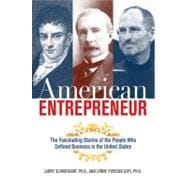
Note: Supplemental materials are not guaranteed with Rental or Used book purchases.
Purchase Benefits
What is included with this book?
LARRY SCHWEIKART, PH.D. (Centerville, OH), a history professor at the University of Dayton, is the author or coauthor of many books, including A Patriot’s History of the United States and 48 Liberal Lies About American History. LYNNE PIERSON DOTI, PH.D. (Orange, CA) is a professor of economics at Chapman University and the editor of Essays in Economic and Business History.
| Preface | p. vii |
| Entrepreneurs: The Essence of Enterprise | p. 1 |
| European Settlement and Business Enterprise in the New World | p. 23 |
| Entrepreneurs in the New Nation: 1787-1840 | p. 53 |
| The Entrepreneurial Explosion: 1820-1850 | p. 81 |
| The Rise of Managers: 1850-1880 | p. 114 |
| Entrepreneurs in the Age of Upheaval: 1850-1880 | p. 151 |
| The Big Business Backlash: 1870-1920 | p. 189 |
| The Emergence of a Consumer Market: 1880-1920 | p. 231 |
| Deliverance and Despair: 1920-1939 | p. 273 |
| Business in War and Postwar America: 1940-1960 | p. 311 |
| Business's Winter of Discontent: 1960-1982 | p. 346 |
| Business in Renaissance: 1982-1989 | p. 375 |
| The New Economy: The 1990s | p. 408 |
| Americans and the Global Market | p. 437 |
| Epilogue: The Recession Returns | p. 461 |
| Notes | p. 465 |
| Index | p. 519 |
| Table of Contents provided by Publisher. All Rights Reserved. |
The New copy of this book will include any supplemental materials advertised. Please check the title of the book to determine if it should include any access cards, study guides, lab manuals, CDs, etc.
The Used, Rental and eBook copies of this book are not guaranteed to include any supplemental materials. Typically, only the book itself is included. This is true even if the title states it includes any access cards, study guides, lab manuals, CDs, etc.